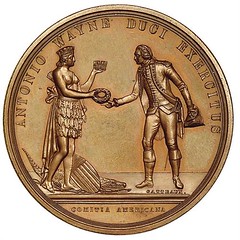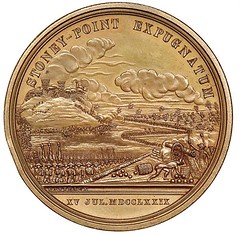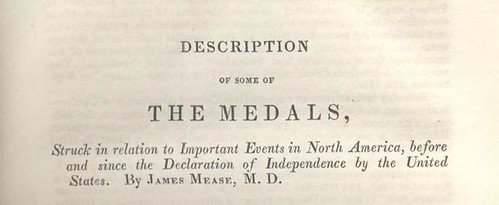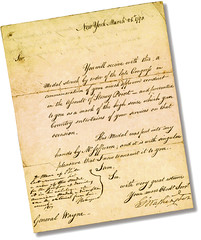
PREV ARTICLE
NEXT ARTICLE
FULL ISSUE
PREV FULL ISSUE
JAMES MEASE, GEORGE WASHINGTON AND ANTHONY WAYNE'S STONEY POINT MEDAL
Yesterday my inbox filled to the brim with notes about a letter and its numismatic connections in an upcoming Sotheby's sale. Several readers saw or heard about a Saturday morning New York Times article mentioning the George Washington letter presenting of a medal to Anthony Wayne.
-Editor
I don't know if you've seen this morning's New York Times, but there's a letter pictured on the front page of the Arts section – which Sotheby's will be selling – that will be of great interest. Dave Bowers was also quick to spot the item. He writes: Today in 2010, and in recent times, there has been a renewed interest in numismatic history and also in early medals—the two go together. John Sallay adds: I believe an original is rare, even in silver/bronze, separate from the gold original presented to Wayne. There was a good U.S. Mint restrike in the Minot Collection of Stacks (5/21-22/08, lot 526).


Len Augsburger writes: As usual, John Adams is way ahead of us, for Washington's letter of transmittal was discussed in his Comitia Americana book in the chapter on the Wayne medal. Kay O. Freeman writes: A friend in New York went to Sotheby's today and saw the J.S. Copley items on advanced preview since sales of that collection do not start until April 2010. The George Washington / Anthony Wayne letter was on view with the Wayne medal, so Copley owned both. The lot is estimated $80,000-120,000. John Adams writes: Thank Heavens that the medal with the letter is from U.S. Mint copy dies. If it were an original, you could add another $100,000 or so to the estimate... Kay adds:
What interests me is what had been added to the letter (at the bottom left) dated March 1817, signed "Wayne". It says: "Dr. Mease of Phila last summer had a view of this medal for the purpose of inscribing it in his catalogue of American Medals, a description can be obtained from him."
General Wayne died in 1796, so he did not add the note. The 1817 notation might have been written by Isaac Wayne, Anthony Wayne's son. Online, there is a Wayne/Penrose bible with family vital dates. There one can see handwriting samples of various Wayne family members and compare with that of letter notation. Who is the Dr. in Philadelphia who was doing a catalogue of medals? Dave Bowers adds: Mease was a pioneer figure in numismatics and is known to serious historians. Appended is a bit about him from my 2001 book, American Numismatics Before the Civil War. At a time when ‘coin collectors' in the United States were popularly considered little better than monomaniacs, two or three gentlemen — Dr. J.B. Felt, of Salem, Mass., Mr. J. Francis Fisher, of Baltimore, and Dr. Jas. Mease, of Philadelphia — were deeply interested in the subject., and communicated the results of their investigations to societies of which they were members, or published them in a separate form. In the 3d vol. of the New-York Historical Society's Collections (pp. 387-404), will be found a highly interesting paper by Dr. Mease, giving a description of 17 medals struck with reference to America; and this paper the Massachusetts Historical Society republished (Coll., vol. 4, 3d Series, 1834), together with additional particulars from the same hand concerning 33 medals presented to the officers of the war of 1812-14; and also of 4 other miscellaneous American medals.… Although Felt would be recognized as the author of a pioneering book, the names of Messrs. Fisher and Mease were scarcely known to a later generation of numismatists. Len Augsburger adds: Regarding the Mease catalog, David Fanning recently offered a copy at in The Bookshelf, Vol. I, No. 3 (May 2009), lot 300. See www.fanningbooks.com/Bookshelf3Web.pdf . What I find interesting about the letter of transmittal is that it mentions a copy of the Mease catalog as of 1817. So far as we know, the catalog initially published in 1821 as an article in "Collections of the New-York Historical Society." This indicates that Mease was at the task even four years earlier.
With permission, below are some excerpts of David Fanning's description of Mease and his catalogue.
-Editor
A landmark of early U.S. numismatic literature, Mease's article in this volume of the Collections of the Massachusetts Historical Society is a revision and expansion of his 1821 article published in the Collections of the New-York Historical Society, the first article written on a numismatic subject for numismatists. While a number of American publications of numismatic interest predate Mease's 1821 article, these early publications were written for merchants, bankers, lawyers, politicians and other people who dealt with monetary issues on a daily basis. Works had not been written from the point of view of one who studies coins and medals. Indeed, no works written for numismatists were published in this country, to the best of my knowledge, between Mease's 1821 article and this 1834 revision. In his groundbreaking lecture on the topic of U.S. numismatic literature, William S.F. Mayers writes, "the first actual attempts at systematic classification and record of the coins struck in or for the American colonies and United States, appear in the shape of papers to be found in the collections of State Historical Societies" ("The Literature of American Numismatics," Norton's Literary Letter, No. 3, 1859, p. 6). Mease's articles are specifically mentioned by Mayers in his article, showing that these works, long forgotten until recent years, were still in the memory of some in the late 1850s. Though the 1821 version of the article is included in Attinelli's masterful 1876 Numisgraphics (p. 109), it is listed under "Historical Society of New York. Collections" with no mention of its contents or importance (and this revision isn't mentioned at all by him). Mease's 1821 article was reintroduced to modern scholars by Eric Newman in the Summer 1992 issue of The Asylum, the quarterly journal of the Numismatic Bibliomania Society, and has since been discussed by Joel Orosz in later issues of the same publication. The Newman article was also published in the August 1992 issue of The Numismatist. James Mease, M.D. (1771–1846) was a polymath who published on an number of different subjects, including medicine, geology, and history. He was well known as the editor of the Domestic Encyclopedia (1803–04) and the Archives of Useful Knowledge (1811–12). His Picture of Philadelphia (1811) is a foundational work of local history and contains the first useful description of the U.S. Mint operations. Active in the American Philosophical Society and the Philadelphia Athenaeum, some of his papers are deposited in the William L. Clements Library at the University of Michigan. Mease would go on to publish the first numismatic examination of American coins in 1838.

Joel Orosz writes: Mease led a fascinating life outside of numismatics. He stayed with Dr. Benjamin Rush in 1793 when most doctors fled the Philadelphia yellow fever epidemic (although the harsh methods they used probably killed many of their patients). He also was the father-in-law of one of the most celebrated actresses of the 19th century, Fanny Kemble. In between, he helped to settle a dispute in Philadelphia about the location of the home where Jefferson wrote the Declaration of Independence, by the simple method of writing Jefferson to ask him. Eric Newman wrote an article about Dr. Mease in The Numismatist back in the 90s, and I wrote one for The Asylum about ten years ago.
Wow - what a great letter, medal, and connection to a pioneer in numismatic literature and research. Thanks, everyone!
-Editor
To read the complete New York Times article, see:
At Sotheby's, Tracing the Lives Behind the Letters
(www.nytimes.com/2010/01/16/arts/design/16sothebys.html)
The Numismatic Bibliomania Society is a non-profit organization promoting numismatic literature. See our web site at coinbooks.org. To submit items for publication in The E-Sylum, write to the Editor at this address: whomren@gmail.com To subscribe go to: https://my.binhost.com/lists/listinfo/esylum All Rights Reserved. NBS Home Page Contact the NBS webmaster 
|
 John Sallay writes:
John Sallay writes: